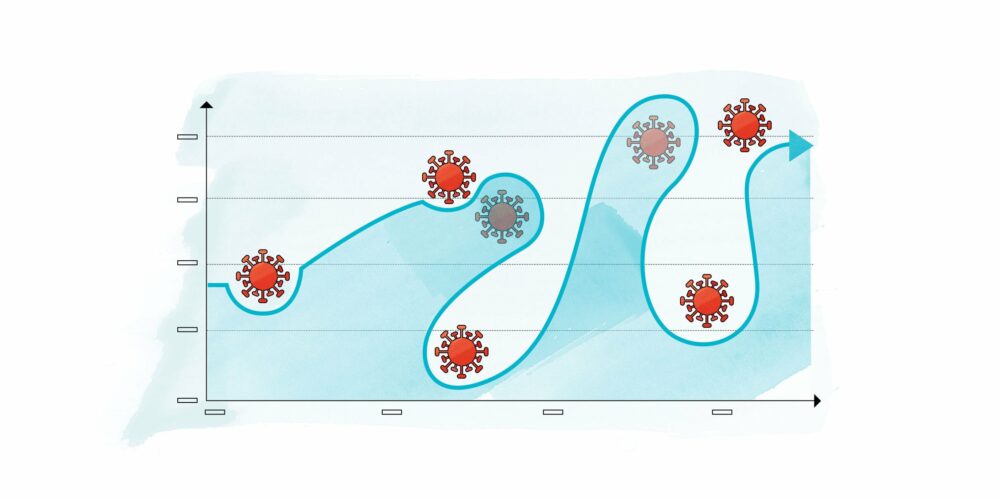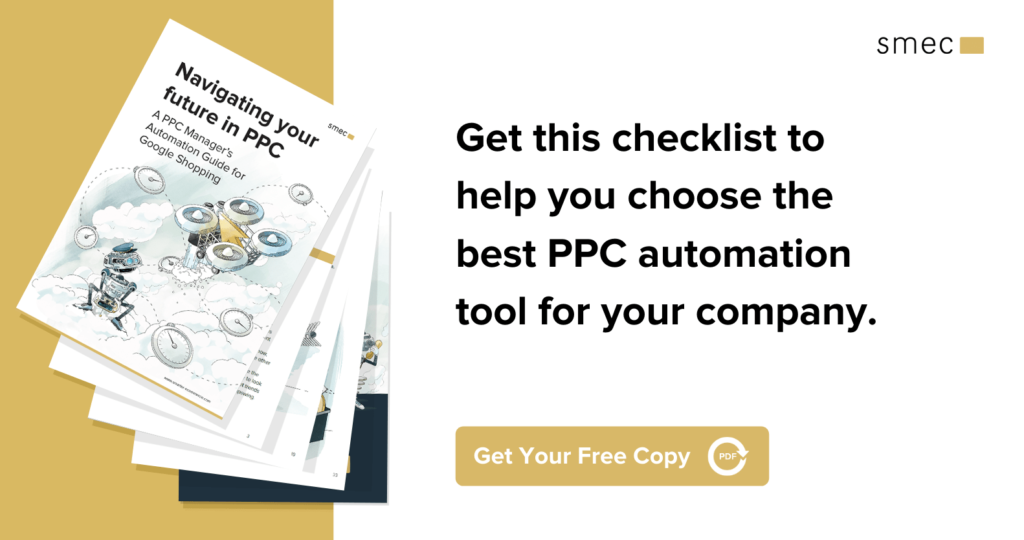Subscribe to join thousands of other ecommerce experts

Automated bidding tools have become a staple of PPC management. But the current health crisis has created problems for the predictive algorithms that underpin this software — problems which may not be obvious to every online marketing manager. Failure to mitigate these flaws can undermine your PPC strategy at the very moment when online sales have set a record-high percentage of all retail transactions.
Fundamentally, the artificial intelligence (AI) and machine learning (ML) that drive bidding automation can and will adapt to the current situation over time. But more importantly, and more immediately, you can deploy a number of strategies to improve your outcomes and help your automation tools better manage unprecedented market fluctuations.
Central to your success will be providing strategic guidance to your automation tools. That means making sure that your business objectives are driving the automation — not the other way around. But before we can get into any of these specifics, we need to address the heart of the problem:
Why are bidding automation algorithms struggling right now?
Table of Contents
The challenge of unprecedented behaviour
Bid automation software deploys machine learning (ML) to make predictions about what bids will be the most effective. ML is a form of artificial intelligence that uses repeated past actions to systematically improve situational decision-making. In other words: ML uses past behaviour to try and predict the present.
Uncertainty boosts the value of prediction, but it also creates a problem. If current behaviour does not align with past trends, there is no basis on which to make reliable predictions. The current situation presents a problem because there is no complete and relevant historical or contextual data for the software to draw upon to try and make sense of what’s happening.
For example, our Market Observer tool (which you can check out for free analysis) shows CPC swings of up to +325% and -95%, depending on the industry. With these types of changes occurring at rapid speed, and manifesting out of abnormal consumer physiological conditions and unprecedented economic changes, automation tools cannot realistically be expected to stay ahead of the curve. At best, they will be reactive. At worst, they will be ineffective.
Should I continue using bid automation software?
Admittedly, this all sounds bad. But it doesn’t really change the reality that bid automation is still your best resource for optimising PPC outcomes.
Product-level bidding is the gold standard of PPC, and for anyone other than the smallest boutique dealers, PPC automation tools are necessary for product-level bids. Even for small businesses, algorithmic analysis brings bidding insights that would otherwise be unobtainable. It’s not like people have all of the answers to the current situation.
In short: yes, you still need your bid automation tools. They just aren’t going to perform as effectively when left on their own.
With that said, this answer does not demand lowering your expectations. Most of us are under pressure to increase PPC conversions while simultaneously reducing costs. Although market volatility increases risk and damages the stand-alone effectiveness of automation, it also creates opportunities.
In order to use bidding automation effectively, you have to play to the strengths and weaknesses of the tool — allowing it to augment your own strengths, rather than replace them. In reality, this is true under any circumstances.

How to improve your PPC automation outcomes today
So, what do you do?
The key to optimising your PPC bid automation strategy right now is control and information. You want to feed your algorithms every bit of information that you can, and help them come to the right conclusions. Most importantly, that means setting out the strategic direction for your business separate from your automation tools, and using a number of levers to set parameters for your tools that conform to those strategic choices.
Here are the four actions you should take now:
1. Align bidding with logistics
A big challenge that retailers are facing is disruption to their supply chains. You bid automation tools won’t know anything about that. It’s up to you to make sure that your PPC budget is spent on products that you actually have in stock and are able to fulfil. You need to set up clear channels of communication with teams in charge of logistical coordination and manually manage PPC budgets on (at least) a weekly basis. Depending on the volatility you are experiencing, it may need to be more often.
What this avoids: The worst way to waste your PPC budget is unaligned spending. By making sure that you are advertising products that you have, you can keep your automation algorithms aligned with the wider elements of your business.
2. Set schedule modifiers
The flexibility provided by schedule modifiers is a great way to manually supply contextual information that your bidding tools can then use to make informed choices. By setting schedule modifiers, you can focus your budget on the time periods that are most important to you. Depending on your bidding tool, you can also input device and location preferences with attached bid modifiers to further customise how your budget is being spent.
What this avoids: Dramatic spikes in demand and fluctuations in pricing can deplete your budget if left to automated decision-making. Setting an open budget is one solution. However, appropriate use of schedule modifiers will allow you to reduce your overall spending and vulnerability to CPC fluctuations.
3. Use custom labels
Custom labels allow you to better segment your campaigns and reflect overarching goals within your bidding strategy — make sure that you use them. For example, you can use custom labels for different margins (high or low), top sellers, cost drivers, different suppliers, etc. You can then set ROAS targets or budgets (depending on the flexibility of your tool) for different custom labels in order to reflect strategic decisions or information obtained from outside sources.
What this avoids: Custom labels enrich your bidding strategy and help align automation algorithms with strategic decisions. Fundamentally, creative use of custom labels allows you to avoid automation tools becoming default strategic decision-makers by providing a flexible means of bidding segmentation.
4. Revisit your search terms
The specifics will vary based on your industry, but you’ll likely see shifts, both minor and major, in the search queries triggering your ads. Responding to this will require you to be reactive by reviewing search terms and display campaign placements in order to make sure that your keyword lists remain up to date. You’ll also need to be proactive, predicting searches that have the potential to trigger your ads and creating negative keyword lists that are easy to update.
What this avoids: By regularly reviewing and updating your search terms (and negative search terms) you can cut down on wasted spending and missed opportunities. Fundamentally, it’s good practice to review your keyword lists every few months. Market volatility simply accentuates the value of regular updates.
New opportunities and an eventual ‘new normal’
While the current crisis has been challenging for many businesses, it’s vital to remember that within challenging times, there are always opportunities for growth. Disruptions are an excellent time to step back, reassess and maybe even reinvest. Just make sure to do this within the broader context of a unified strategic approach.
When it comes to PPC bid automation, it’s more critical than ever to keep a watchful eye on the decision your algorithmic assistants make. To be honest, this is always good practice. But you should remember that machine learning is always learning. As the current situation continues, algorithms will slowly improve their ability to predictively respond.

When it comes to the tools you select, the one thing this crisis highlights is the value of customisation and control. ‘ROAS targeting’ is another valuable feature right now. The ability to set minimum ROAS targets (as opposed to just budgets and maximum bids), improves your ability to align business priorities with bidding strategies, while also maximising impressions. Equally, sophisticated algorithms that update daily and control item level bids will have an easier time responding to uncertainty.
Check out our blog about the best PPC automation tools of 2020 if you are interested in an overview of the current market. It’s also worth noting that the right partner can act as a PPC agency, helping businesses set up and optimise the software, delivering reporting and analytics reviews and providing invaluable strategic guidance.
Social distancing is accelerating the role of ecommerce in retail. Because of this, the sector will only become more competitive. In the current climate, you need to think both long-term and short-term. Doing so will help your business flourish and remain competitive, even in these uncertain times. Stop reading and start planning.
smec Market Observer
To support you in times of uncertainty even more, we created the smec Market Observer. It provides you with trustworthy PPC data from various industries and valuable analyses enabling you to better understand how your market is changing so you can make better-informed decisions.

